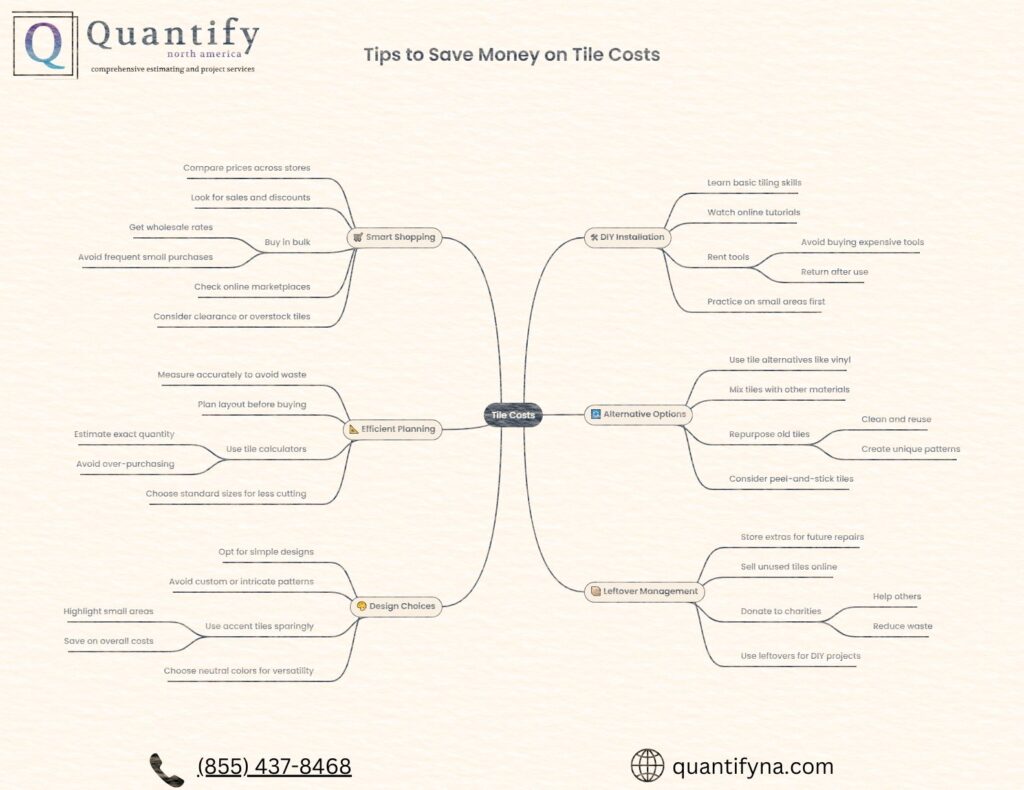Renovating your space with beautiful tiles can completely transform the look of your home. However, without proper planning, tile costs can quickly add up. Knowing how to calculate tile cost per square foot can help you stay within budget while achieving your dream design.
This guide will walk you through the steps to calculate tile costs and provide tips to save money on your renovation.
Step 1: Measure the Area to Be Tiled
Start by determining the total square footage of the area you want to tile. Use a tape measure to get the dimensions of the space. For square or rectangular areas, multiply the length by the width. If the area has irregular shapes, divide it into smaller sections, calculate the square footage of each, and then add them together.
Why Accurate Measurements Matter
Accurate measurements ensure you buy the right amount of tile. Overestimating leads to unnecessary expenses, while underestimating causes project delays due to insufficient materials.
Construction estimating is key to avoiding unexpected expenses, offering detailed breakdowns for seamless project execution. This step is foundational for budget control and efficient planning.
Example:
- A kitchen backsplash that is 10 feet long and 2 feet high:
For more complex areas like bathrooms with nooks or alcoves, break the space into smaller, measurable sections. Sketching the layout can help visualize the calculations and avoid mistakes.
Step 2: Check the Price of Your Chosen Tile
Tile prices vary widely depending on material, size, and design. Common tile materials include ceramic, porcelain, natural stone, and glass. Visit your local tile supplier or check online stores to get the price per square foot of your preferred tile.
Factors Influencing Tile Prices
- Material Type:
- Ceramic Tiles: Affordable and versatile, priced between $2 to $5 per square foot.
- Porcelain Tiles: Durable and water-resistant, costing $3 to $10 per square foot.
- Natural Stone Tiles: Luxurious and unique, ranging from $7 to $20+ per square foot.
- Size and Shape:
- Larger tiles often cover more area and reduce grout lines, but they may cost more.
- Intricate shapes, like hexagons or mosaics, usually come at a premium.
- Design and Finish:
- Textured, patterned, or glazed tiles tend to be pricier than basic designs.
- Supplier and Brand:
- High-end brands and specialty stores often charge more, but bulk discounts may be available.
Example Prices:
- Ceramic tiles: $2 to $5 per square foot
- Porcelain tiles: $3 to $10 per square foot
- Natural stone tiles: $7 to $20+ per square foot
Step 3: Calculate Tile Cost
Multiply the total square footage of the area by the price per square foot of your chosen tile.
Formula:
Detailed Calculation Example
- Area: 20 square feet
- Tile price: $5 per square foot
This straightforward calculation gives you the base cost for tiles. However, it’s important to consider additional expenses to get an accurate project estimate.
Step 4: Factor in Additional Costs
Tiles are just one part of the equation. Consider other expenses that impact the overall cost:
1. Underlayment and Adhesive
- Depending on the surface, you may need materials like backer boards, mortar, and grout. These ensure the tiles adhere properly and remain durable.
- Estimated Cost: $1 to $3 per square foot.
2. Installation Costs
- Professional installation can range from $4 to $8 per square foot. DIY installation can save money but requires time, tools, and skill.
3. Waste and Extras
- Buy 10-15% extra tiles to account for cutting, mistakes, and future repairs. Skimping on this buffer can lead to mismatched tiles if replacements are needed later.
Example:
- Waste buffer: 15% of 20 square feet = 3 extra square feet
- Total tiles needed: 20 + 3 = 23 square feet
- Cost of extra tiles: 3 $5 = $15
Step 5: Add It All Up
Combine all costs to get the total expense. Including every detail ensures you’re not caught off guard by unexpected expenses.
Example Breakdown
- Tiles: $100
- Adhesive and grout: $30
- Installation: $160 (20 square feet $8 per square foot)
- Waste buffer: $15
Total Cost: $100 + $30 + $160 + $15 = $305
Tips to Save Money on Tile Costs
Tile flooring can be a beautiful and durable choice for your home, but it doesn’t have to break the bank. With a few smart strategies, you can save money on tile costs without compromising on quality or aesthetics. Let’s discuss some tips to consider:

1. Plan Ahead
Careful planning is crucial to avoid overspending. Measure the area accurately to determine how much tile you need, and add a small buffer for cuts and breakage. Over-ordering can lead to unnecessary expenses.
2. Shop Sales and Clearance Sections
Many retailers offer discounts on overstock or discontinued tiles. Clearance sections can provide high-quality tiles at a fraction of the cost. Be flexible with your design to take advantage of these deals.
3. Consider Alternatives
Natural stone and designer tiles are often expensive. Opting for ceramic or porcelain tiles can mimic the look of high-end materials at a more affordable price. Additionally, larger tiles cover more area, reducing grout and labor costs.
4. Mix and Match
Combine premium tiles with budget-friendly options to create a unique design. For example, use expensive tiles as accents or borders and fill the rest of the area with more economical choices.
5. DIY Where Possible
If you’re handy, consider installing the tiles yourself. Labor can account for a significant portion of tile installation costs, so learning to do it yourself can result in substantial savings. However, ensure you’re confident in your skills to avoid costly mistakes.
6. Buy from Wholesalers
Purchasing tiles directly from wholesalers can often save you money compared to retail prices. Look for local suppliers or online stores with competitive rates.
By following these tips, you can enjoy stylish and durable tile flooring without overspending.
Understanding Long-Term Savings
Investing in high-quality tiles and professional installation may seem costly upfront but can save you money in the long run. Durable tiles require less maintenance and last longer, reducing the need for replacements. Additionally, a well-done tile project can increase the value of your home, making it a worthwhile investment.
Maintenance Tips
- Regularly clean tiles with appropriate cleaning solutions to maintain their appearance.
- Seal grout lines periodically to prevent discoloration and moisture damage.
- Replace damaged tiles promptly to avoid further issues.
Common Mistakes to Avoid
- Underestimating Costs:
- Forgetting to factor in adhesive, grout, and waste can lead to budget overruns.
- Skipping a Waste Buffer:
- Not buying extra tiles can cause mismatched replacements later.
- Choosing the Wrong Tile:
- Select tiles suited for the space. For example, avoid slippery tiles in bathrooms or outdoor areas.
- Improper Installation:
- Uneven surfaces or incorrect adhesive application can result in poor finishes and future repairs.
Final Thoughts
Calculating the tile cost per square foot is an essential step in managing your renovation budget. By measuring carefully, factoring in additional expenses, and following money-saving tips, you can achieve a stunning tiled space without breaking the bank.
Quantify North America specializes in providing precise and efficient estimating services for all your renovation needs. Our team ensures you get accurate tile cost calculations, helping you stay within budget and avoid unnecessary expenses
Trust Quantify North America to simplify your renovation process and ensure your project is a success. Contact us today to learn more about our services and how we can help bring your vision to life.




